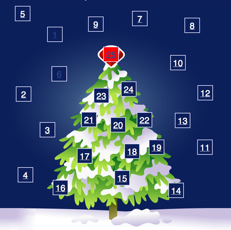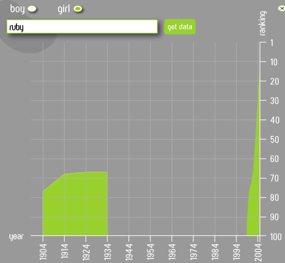Amy Hoy has written a great tutorial running through the Rails console that’s suitable for both complete novices and experts (there are a couple of tricks she mentions that I didn’t know at least!). Amy appears to have taken up Slash7 with a new zeal lately, so let’s hope we’ll see more great content like this on her blog through 2007! Read More

Over at RedHanded, why the lucky stiff has presented a great round up of the life of Ruby in 2006. He also has about 30 quotations specially collected from various people in the Ruby community (including me) that sum up 2006 in terms of Ruby. It’s a great read. Read More

I promised a quick round up of all of the days on the 2006 Ruby Advent Calendar for those who didn’t want the agony of reading it every day, so here you are:
I promise this is the last mention of the advent calendar until at least next Fall! Read More

ZiYa is a Rails plugin developed by Fernand Galiana and DeLynn Berry that makes it a snap to create complex charts to show in your Rails applications. It uses Flash as the engine for creating and showing the charts, but you don’t need to have any Flash knowledge to use the plugin as all of the parameters are passed through from Ruby. Read More
“How To Think Like A Computer Scientist” is a range of online books (distributed under the GNU Free Documentation License) developed by various authors each focusing on a different programming language and explaining computer science concepts with it. Elizabeth Wiethoff has now started the Ruby edition and has made her work so far available online.

Mr. Neighborly’s funky Ruby book is now available to read online (or as a PDF), but, naturally, if you want to support him (or if you read the PDF or HTML version and find it entertaining) then there’s a print version you can buy too for an extremely reasonable $10. Read More

Christmas Day deserves a frivolous story! How about the incredibly rapidly growing popularity of the name “Ruby” in the UK? Reasonably popular until the mid 1930s, the name dropped off the charts until around 2000. Since 2002 the name has leaped from the 70th most popular girl’s name up to 4th!
Unfortunately, however, the surge in popularity is not likely to be linked to the Ruby programming language’s prowess, but more to the surge in popularity of ‘old names’ and the character of Ruby Allen in the nation’s favorite soap, EastEnders, with the Office for National Statistics even attributing the rise in popularity to the character. Read More

I’m taking a break for a several days over Christmas. I would schedule a few posts to run, but I tend to find people don’t want to be online over this period anyway! However, the Ruby Advent Calendar continues regardless. If you haven’t been checking it out, drop by now for 20+ days of tips, libraries, useful Ruby sites, and other nuggets of Ruby goodness. It runs right up until Christmas Day. Expect to see the blog back in action from Wednesday, 27th December, and till then.. have a merry Christmas!
Note: After Christmas is over there will be a post linking to all of the advent calendar days separately for those who don’t want to follow the calendar directly. Read More

Note: This story actually dates back from May 2006, but I don’t remember hearing about it then, and it’s tucked down inside Alexa’s Developer’s Corner.
Using the Alexa Web Search Platform as a source of data, Derrick Pallas put together a search engine using Ruby, RMagick and Amazon S3. With AWSP’s data set and CPU cluster he fetched 5,000,000 photos from the Web, analyzed their EXIF info with RMagick , and uploaded them to Amazon S3. The result was Camera Image Search, a search engine that can show you pictures taken with certain cameras or with certain exposure times / focal lengths / etc (for some reason the Manufacturer drop down does not appear to work, but other fields do). Read More

Heckle is a great new library from Kevin Clark (though Ryan Davis wrote a proof of concept at RubyConf) that ‘torments your tests’. It uses ParseRuby and RubyToRuby to rip your code apart and forces random data into your code (currently it does this for strings, symbols, regexps, ranges, booleans, and numbers) to see how good your tests really are.
Simply, it’s fuzz testing for your Ruby tests, and that’s a good thing if you want your test suites to be strong and far-reaching. Read More

Geoffrey Grosenbach demonstrates how you can use Rails 1.2′s “respond to” features to return dynamic graphic files on request. Short, sweet, to the point, and a great demonstration of the dynamic response capabilities of Rails 1.2. Read More

Chris Wanstrath laments that the Ruby Inside Advent Calendar isn’t Rails-specific, and since Rails does ‘everything faster’, he has produced an entire Rails Advent Calendar in one post! Curiously though, Planet Err has 39 days leading up to their Christmas.. but regardless, Chris presents 39 choice Rails snippets. Read More

If you haven’t got tab-completion and syntax coloring in your irb, you owe it to yourself to follow these instructions right away (should work for Linux, OS X, and Cygwin users). First, install the Wirble gem:
sudo gem install -y wirble
Next, create or edit a file called .irbrc in your home folder (~/.irbrc), and make sure these lines are included there:
require ‘rubygems’
require ‘wirble’
Wirble.init
Wirble.colorize
Now play with irb and see joy similar to that in the screenshot above. Try tab-completion too. It’s great! Read More

Almost anyone who’s tried to install Image/GraphicsMagick and RMagick on several different systems has experienced the pains of compilation, having to download this and that, and inconsistencies here and there. When all you want to do is produce some quick thumbnails from your Rails app, you can quickly feel it’s a bit overkill.
Enter ImageScience, a “clean and happy” Ruby library focused on producing thumbnails quickly and easily. According to the author it “kicks the living crap out of RMagick” and “doesn’t leak memory like a sieve”. I haven’t experienced any issues with RMagick myself, beyond the installation of its dependencies, but I haven’t been paying attention. Read More
css_dryer is a Rails plugin by Andrew Stewart that makes putting together stylesheets for your Rails applications more efficient than ever before. It supports nesting and basic variable interpolation. For example, here’s an example of nesting:
div {
/* comment for div */
color: green;
p {
/* comment for div p */
color: red;
b { color: blue; }
}
}
And using variables makes it easy to update constants in your stylesheet:
<% sleek_grey = ‘#fefefe’ %>
#sidebar { border: 1px solid <%= sleek_grey %> }
#footer { footer: 1px dashed <%= sleek_grey %> }
Andrew has put together some great instructions on how to get it all going here. Read More







